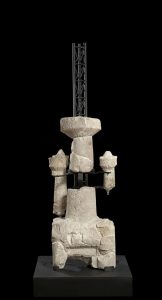Sardinia Part One: Welcome to a Summer of Archaeological Conservation


Grove City College offers its students many different, and unique opportunities to not only better themselves, but to experience unique adventures. Many of these adventures take place on United States soil, but several of them are abroad. Unique partnerships with international institutions offer GCC students exceptional opportunities to explore their vocational interests, obtain outstanding job experience, and gain appreciation for new professions. In this post, one of the more unique opportunities Grove City College offers will be explored — Welcome to archaeological conservation in Sardinia, Italy.
Now, I’m sure you have several questions probably rolling around in your head. They may include:
“Archaeological Conservation? Is that when they dig stuff up from the dirt?”
“Sardinia…I’ve never heard of that. Where in the world is that? Is it really part of Italy?”
“Great, so you’re going to tell us about how you dug up rocks all summer? Sounds like so much fun.”
The subject might sound as dry as the rocks we worked with, but you might be surprised at how you are wrong. First, what is archaeological conservation? Archaeological conservation is the preservation of items which make up our history. Conservationists repair structures, art, pottery, sculptures, mosaics, and so much more. Yet they also work with museums, governments, and private individuals to clean, categorize,  reassemble, and display ancient pieces which were discovered in archaeological digs. Every statue that you see in a museum, every piece of pottery, has been preserved by a conservationist.
reassemble, and display ancient pieces which were discovered in archaeological digs. Every statue that you see in a museum, every piece of pottery, has been preserved by a conservationist.
There are very few conservationists around the world, and opportunities to experience their work are few and far between. This makes the fact that Grove City College offers a month long archaeological conservation trip all the more exciting. The school sponsors students to go, in a group, to Sardinia to work on the Mont’e Prama Project. Dr. Nardi is a world renowned archaeological conservationist who not only is very good at what he does, but also is extremely kind and friendly. He loves meeting students, working with them, opening their eyes to a new world, and building community with them. We handled pieces of art which were thousands of years old, and were extremely delicate. If a paintbrush pressed too hard against a stone, there is a high possibility it would crumble away. Considering how fragile these artifacts are, the Italians never gave anything but patient, level-headed instruction.
The Project of Mont’e Prama
The research assignment we worked on was called the Mont’e Prama Project. We studied two different types of figures; the Giganti, and the Nuraghe. The Giganti, or the Giants, are eight-foot-tall warrior statues made out of sandstone. The Nuraghe are primitive castles figurines which vary in size. Some were smal l enough to hold in your hands, and others were big enough to need a truck to move. The Nuraghe models are believed to be based off of full size ‘castles’ which are scattered around the island.
l enough to hold in your hands, and others were big enough to need a truck to move. The Nuraghe models are believed to be based off of full size ‘castles’ which are scattered around the island.
While both are important groups of artifacts, the Nuraghe models have been found across the island while the Giganti have only been discovered in one small piece of land. A farmer found these artifacts while plowing on the archaeological site. The Giganti were in an ancient graveyard, but their purpose is unknown, as is the purpose of the Nuraghe models. The archaeological dig site itself unearthed the fragments we worked with in the 70’s. There were 27 crates of fragments that we students worked with. The crates contained anywhere from one large fragment to 80 small fragments. It is estimated that by the end of the month, we handled over 500 individual fragments — quite the number.
Conclusion
All in all, the experience was amazing. I developed an appreciation for how much work truly goes into, not only the archaeological process, but the curation and museum work that goes into preparing and presenting a piece. I was also astonished at how many fragments and pieces are not on display. For every piece you see in a museum there are hundreds of pieces not on display, and thousands of unidentified fragments sitting in the basement. I learned patience in the process, and I got to see first-hand how much passion for the subject is required from those who chose it as their profession.